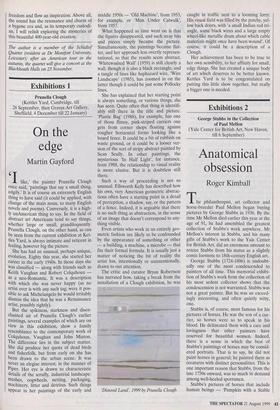Exhibitions 2
George Stubbs in the Collection of Paul Mellon (Yale Center for British Art, New Haven, till 6 September)
Anatomical obsession
Roger Kimball
he philanthropist, art collector and horse-breeder Paul Mellon began buying pictures by George Stubbs in 1936. By the time Mr Mellon died earlier this year at the age of 91, he had assembled the greatest collection of Stubbs's work anywhere. Mr Mellon's interest in Stubbs, and his many gifts of Stubbs's work to the Yale Center for British Art, did an enormous amount to rescue Stubbs from his status as a slightly comic footnote to 18th-century English art.
George Stubbs (1724-1806) is undoubt- edly one of the most condescended to painters of all time. This memorial exhibi- tion of Stubbs's work from the collection of his most ardent collector shows that the condescension is not warranted. Stubbs was not a great painter. But he was an exceed- ingly interesting, and often quietly witty, one.
Stubbs is, of course, most famous for his pictures of horses. He was the son of a cur- rier, so horses were so to speak in his blood. He delineated them with a care and lovingness that other painters have reserved for beautiful women. Indeed, there is a sense in which the best of Stubbs's paintings of horses may be consid- ered portraits. That is to say, he did not paint horses in general; he painted them as creatures with distinct personalities. This is one important reason that Stubbs, from the late 1750s onward, was so much in demand among well-heeled sportsmen.
Stubbs's pictures of horses that include human beings — 'Pumpkin with a Stable Lad' (1774), for example — can be slightly disconcerting precisely because the beast emerges with far more spark and individu- ality — far more humanity, one might almost say — than the man. People in Stubbs's animal pictures are rarely more than stage props. Gulliver would have found Stubbs to be the ideal artist to accompany him on his voyage to the coun- try of the Houyhnhnms. Stubbs did not share Gulliver's misanthropy, but he would have understood his respect for horses. As I write, the Tate in London is showing an exhibition called Abracadabra: International Contemporary Art, which features as a kind of teaser a stuffed horse hanging from the ceiling. Stubbs's painstaking acts of homage to the horse provide a good anti- dote to such trashy obscenity. Stubbs was self-taught, and it shows. His art is parochial and idiosyncratic. He com- manded considerable technical skill, but he never really mastered the knack of enliven- ing the whole surface of his paintings or drawings. Memorable though it often is, his art rarely transcends illustration. The sub- ject — be it a horse, a dog, a zebra — gets all of the attention, while the rest of picture is mere background. Stubbs painted a whole series depicting a lion attacking a horse. The pictures in this series are mar- vels of anatomical observation. But com- pared, say, to Delacroix's vibrant animal pictures, they seem curiously static. Stubbs handled paint and his printmaker's tools for the sake of exactitude, not expression. He sought a highly polished finish for his paintings, and came late in life to experi- ment with enamels on copper and — work- ing with Josiah Wedgwood — on glass and ceramic. This medium, although successful- ly avoiding the craquelure Stubbs abhorred, increased the static quality of his images, further marmorealising the animal energy he was so careful to trace.
Stubbs took extraordinary, almost grotesque, pains to master equine anatomy. As one commentator notes, he 'devised a tackle for hauling a horse into lifelike atti- tudes, after which he proceeded to strip away layer after layer of skin and muscle to the skeleton, making drawings and notes at every stage'. Stubbs's only helper in this grisly business was Mary Spencer, his com- mon-law wife, who must have been power- fully devoted to her husband to participate in such exercises.
Stubbs's obsession with anatomy was not confined to horses. In 1795, when he was over 70, he embarked on an ambitious series of drawings called 'A Comparative Anatomical Exposition of the Structure of the Human Body with that of a Tiger and a Common Fowl'. Although it was unfinished at his death in 1806, Stubbs did complete over 100 drawings for the cycle, more than a dozen of which are on view at Yale. They are ferociously exact without quite being clinical. 'Human Figure, Lateral View, Undissected'; 'Tiger, Lateral View, with the Connective Tissue Overlying the Muscles Removed'. It sounds like something Damien Hirst might dream about. In fact, though, these drawings — like Stubbs's work taken as a whole — have a pleasing, evocative authority, especially when seen en masse. George Stubbs certainly doesn't represent the pinnacle of Western art, but neither does he occupy those nether regions that the Tate and other 'advanced' institutions have made so unpleasantly familiar to us lately.
A Zebra, 1763, by George Stubbs



























































 Previous page
Previous page